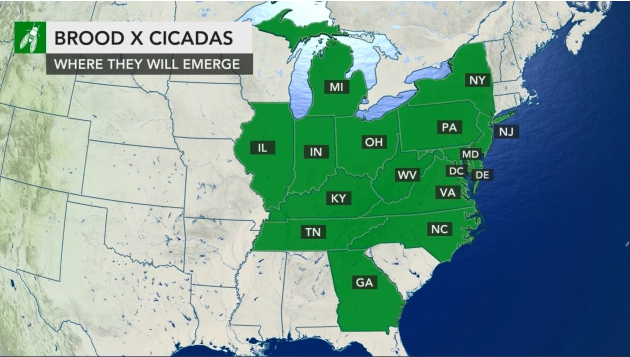Like something out of a horror movie, cicadas are just plain creepy with their dead, bulbous red eyes and constant, squeaky chirp. And they are soon to be here, back from their 17-year hibernation of sorts. In a swarm given the sci-fi-like name Brood X.
13 and 17 Year Cicada Species
While there are 3,000 species of cicadas who come out every year in smaller groupings, the 13 and 17-year species come out in mass. A single female can lay over 600 eggs, which slide underground and into cracks in roots of trees where they drink from them. Besides being annoying, they can be a threat to young trees and bushes. Then there are the thousands and thousands of husks abandoned as nymphs grow into adults.
missing or outdated ad configAccording to the University of Tennessee Institute of Agriculture (UTIA), “Two races of the periodical cicada exist. One race has a life cycle of 13 years and is common in the southeastern United States. The other race has a life cycle of 17 years and is generally more northern in distribution. Due to Tennessee’s location, both the 13- year and 17-year cicadas occur in the state. Although periodical cicadas have a 13- or 17-year cycle, there are various populations, called broods, that emerge at different 13- or 17-year intervals.”
Scientific American notes that Brood X is a 17-year species, a part of a special grouping called “periodical cicadas,” and it has memorably appeared in 1987 and 2004. “There are only 15 periodical broods in the world,” says an article on the Scientific America website, “all of them found exclusively in the eastern United States. Brood IX, another 17-year swarm, emerged last year across North Carolina, Virginia and West Virginia. Brood VIII came out the year before.”
If you were around in 2004, you remember that they were everywhere. Well, they are set to emerge from their underground wombs sometime in mid-May. Beware!
Brood X Cicada Map
Brood X Cicadas are expected to emerge in the states shown on the map below, according to AccuWeather.com.

They will be mild in Middle Tennessee, but heavy in East Tennessee, according to the Tennessee Department of Agriculture.

Superstitions and Truths About Cicadas
According to UTIA’s website, American indigenous peoples believed that the emergence of large numbers cicadas was a sign that something evil this way comes, and early colonists saw it as similar to the plague of the locusts in ancient Egypt written of in the Bible. A punishment. The pronounced “W” on their wings was seen as a harbinger of war.
Today we don’t fear them as early colonists did, but we certainly don’t like them. The massive volume can wreak havoc on crops. According to UTIA, adult cicadas do not eat foliage. But, young twigs and tree limbs may be damaged when females dig into them to lay their prodigious number of eggs, killing the twigs and weakening the tree limbs.
Cycle of Development
Adult cicadas emerge in early May when the soil temperature at four inches deep is 67 degrees Fahrenheit according to UTIA, and then the singing starts as the males call to the females to mate. They work quick as their life cycle is only four or five weeks.
“Mating then occurs and females begin laying eggs. The female cicada has a knife-like ovipositor that she uses to slit twigs of woody plants,” says the UTIA website. “Apple, pear, dogwood, oak and hickory are favorite hosts; however, many others have been reported. In each slit, the female lays 24 to 28 eggs. She then moves forward to cut another slit and deposits more eggs. This continues until five to 20 slits have been made in the twig; then she seeks another twig. Twigs or branches with a diameter the size of a pencil are most often damaged. Each female can lay a total of 400 to 600 eggs.”
The eggs hatch in six to seven weeks into what are called nymphs, which look like white ants. After birth, they drop to the ground and work their way into the soil until they find juicy roots to drink as they develop over the next 17 years.
Keeping Plants Safe
As Scientific America reports, “periodical cicadas draw strength in numbers. Individually, they’re easy targets for birds and other insect-eating animals; they’re large, flashy and easy to spot. Swarming out by the billions gives them an advantage against predators—it increases the odds that enough of them will survive to carry on the next generation.
Since birds are not going to get them, the best way to keep trees and plants safe is to cover them with cheese cloth or tobacco netting. Trees can be pruned after the end of the five-week cicada season, then damaged and week branches and twigs can be removed.
Do not try to kill them with pesticides, as they do nothing to them, according to Prevention. And do not handle them with bare hands.


